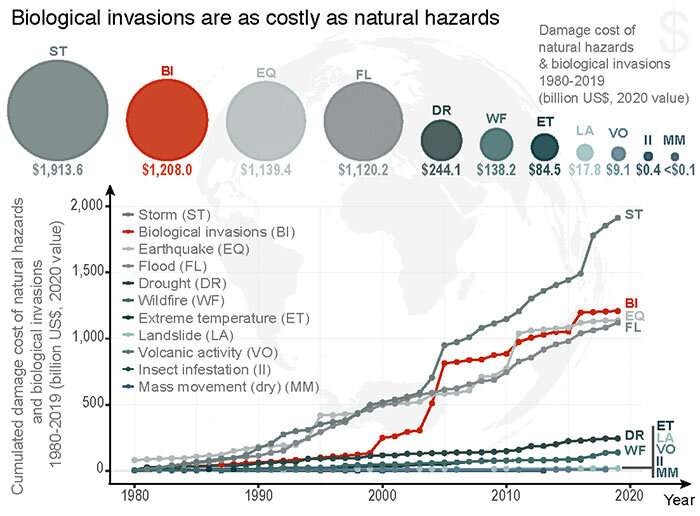This article has been reviewed according to Science X's editorial process and policies. Editors have highlighted the following attributes while ensuring the content's credibility:
fact-checked
trusted source
proofread
Biological invasions as costly as natural disasters, study finds

By invading new environments, some alien species have caused disastrous consequences for local species and ecosystems, as well as for human activities—damage to infrastructure, crops, forest plantations, fishing yields, health and tourism. The areas affected are multiple and the damage is costly.
In a new study published in Perspectives in Ecology and Conservation, an international research team led by scientists from the Écologie, systématique et évolution (CNRS/Université Paris-Saclay/AgroParisTech) reveals an explicit order of magnitude: the global economic impact of these biological invasions is equivalent to that of natural catastrophes. From 1980 to 2019, financial losses due to invasive alien species amounted to $1,208 billion (US), compared to nearly $1,914 billion in losses caused by storms, $1,139 billion attributed to earthquakes and $1,120 billion due to floods.
Scientists have also found that the costs of biological invasions increased more rapidly than those of natural disasters over a given period. Invasive alien species have a long-lasting and cumulative effect: for example, the zebra mussel is capable of attaching itself to a wide variety of substrates, wreaking havoc on everything from ship hulls to nuclear power plant pipes. Its spread is particularly problematic in North America.
To date, investments in preventing and managing biological invasions are ten times lower than the financial losses caused by them. For this research team, these results call for the deployment of action plans and international agreements on limiting the advance of invasive alien species, similar to those implemented in the context of natural disasters.
These results were obtained using the InvaCost database, which currently lists over 13,500 costs due to biological invasions worldwide. The costs of natural disasters at the global level were compiled using the International Disaster Database and data from the US National Oceanic and Atmospheric Administration (NOAA).
More information: Anna J. Turbelin et al, Biological invasions are as costly as natural hazards, Perspectives in Ecology and Conservation (2023). DOI: 10.1016/j.pecon.2023.03.002
Provided by CNRS



















